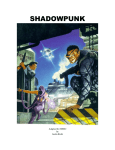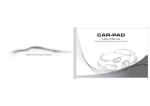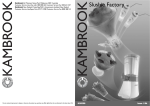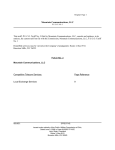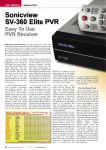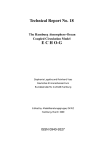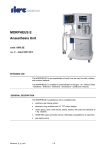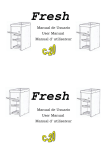Download Morpheus Morpheus - Heidelberg University
Transcript
1i Morpheus Morpheus Morpheus Heidelberg College Student Literary Magazine Fall 2007 Heidelberg College Morpheus Fall 2007 i 1ii Morpheus Contents About this Publication iii “No Country for Old Men” by Alex Doepker Author Biographies iv “Sacrificial Straw Men and the Heart of Hollowness” by Gary Gondek CONTEST WINNERS 28 30 “Abandoned” by Jonnatha Mayberry 1 ENGLISH 492 PROJECTS “Bar Lights” by David Young 2 About this Section: ENG 492 35 Photo by Nikki Locker 4 Author Biographies: ENG 492 36 “Unsettling Waters” by Craig Conrad 5 “Strangers” by Devon Walsh 39 “Poem” by Sarah Reed 8 “Maple Tree” by Abby Strack 50 “Early Morning Delivery” by Jeremy Franks 9 “Family” by Deena Marlette 66 Photo by Mi-Yan Carter 12 “The Invitation” by Robyn Kunsman “The Freedom to Fly” by Nikki Locker 13 “The Secret Lives of Inspiration” by Ris Cashdollar 133 “Instruction Manual” by Jaimie Figueroa 16 “Wreath Hill” by Gabriel Greenfield “On this Stone” by Abby Hockman 25 “A Boy and His Dog” by Abby Hockman 26 Photo by Ben Schwarz 27 Heidelberg College Morpheus Fall 2007 107 149 ii 1iii Morpheus About this Publication Welcome to the Fall 2007 edition of Morpheus, Heidelberg College’s student writing magazine. This year’s issue marks a departure for the publication in several ways. First, we’ve gone electronic, which allows us to share the best writing at Heidelberg with a wider readership. Second, the production of the magazine has become a component of English 492, the Senior Seminar in Writing; this change has allowed us to add a significant practical experience to the course. Third, the publication combines the winning entries of the Morpheus writing contest with the major writing projects from senior seminar. The magazine will be organized into two sections: the winners of the Morpheus contest, followed by the major writing projects. Enjoy! Editors-in-Chief Ben King Devon Walsh Contest Director Robyn Kunsman Marketing Director Deena Marlette Layout & Design Director Abby Strack Publication Assistant Ris Cashdollar Contest Judges Vicki Ohl Marc O’Reilly Julie O’Reilly Gary Dickerson Scott H. Clarke Dave Kimmel, Publisher William Reyer Ruth Wahlstrom Douglas Collar Heidelberg College Morpheus Fall 2007 iii 1iv Morpheus Author Biographies Mi-Yan Carter is from Lorain, OH. She is a junior majoring in Communication & Media and minoring in Film Studies. Mi-Yan’s goal is to work in the film industry, and her dream is to film a documentary. She likes photography because it is her way of relieving stress. The particular photography piece she submitted was taken one sunny day while hanging out with a friend. She liked the shadow that was cast and decided to take the picture. Craig Conrad is a junior majoring in Water Resources. Craig’s hometown is Risingsun, Ohio where he lives with his parents and two younger sisters. Craig graduated with honors from Lakota High School in 2005 where he was involved in many activities including student council, show choir, National Honors Society, football, and track. Craig graduated with honors from Terra Community College in 2007 where he was involved in Phi Theta Kappa and received an Associates Degree in Pre-Engineering. His hobbies include tracking weather, watching sports, playing videogames, collecting Hot Wheels, and spending time with family and friends. Jaimie Figueroa is from Cleveland, OH. She’s a computer science and English writing double major. She will be graduating in May 2009. Jaimie wrote this manual as one of the projects for her Technical Writing class this semester. Jeremy Franks is a freshman history major. Gary Gondek is a senior here at Heidelberg College. He is from Avon Lake, Ohio, and is majoring in English literature and music with a voice emphasis. In addition to academic writing, Gary enjoys writing prose fiction. His contribution to the Morpheus is a paper on T. S. Eliot’s poem “The Hollow Men” and its post-World War I political commentary. Abby Hockman is a sophomore English literature major with a history minor. Her hometown is Lancaster, Ohio. “A Boy and His Dog” is a story about abuse, stressing its expansive damages on four different characters. “On This Stone” is a personal reflection on the loss of her mother. Alex Doepker is a senior communications and theatre arts major. Heidelberg College Morpheus Fall 2007 iv 1v Morpheus Nikki Locker is a senior from Westlake, OH, double majoring in Theatre Arts and Early Childhood Education. An artist from an early age, Nikki was on the Morpheus staff for the last three years and has contributed to the Morpheus every year. Some of her past submissions include “Normal, Illinois,” “Here I Am,” and several photographs. David Young is a transfer student from Findlay, Ohio studying English with a concentration in literature. This is his first semester at Heidelberg. David has been writing for years, but “Bar Lights” is the first piece of work he has ever submitted for any type of publication. Jonnatha (Jonna) Mayberry is a sophomore English writing major. She is from Fayette, Ohio. Jonna writes a lot of poetry in her free time, but this was her first time ever submitting her writing. Sarah Reed is a biology major with minors in chemistry and psychology. She’s a senior from Wooster who is currently interviewing at a number of medical schools. Sarah wrote this piece as a song for the Jena 6 rally. Ben Schwartz Schwarz is a junior psychology major. He has red hair, and he has quite the lumberjack-esque body. He is a founding member of Rho Eta Delta, and he is also the winner of almost everything in life. Ben never fails. Ben enjoys collecting pens and certain types of antique toilet paper (scented or non-scented). Ben also wants to thank everyone for putting a “T” in his last name. Guess what: it doesn’t belong there! Heidelberg College Morpheus Fall 2007 v 11 Morpheus Abandoned Third Place Poetry By Jonnatha Mayberry Chipped paint falls from the walls of the old farmhouse. Years have gone by since anyone has lived here. Once, these rooms had been filled with laughter. Now these walls hold only pure silence. The windows are looking out over life. Spectators look in at darkness. People will be curious. They always are. Emptiness remains. Still. Heidelberg College Morpheus Fall 2007 1 12 Morpheus Bar Lights By David Young You never seem to notice the quick glances I steal when we are together. You sit next to me and all the time we talk, I patiently wait for you to turn your eyes for a moment. Even as we talk I spend the night noticing everything about you in the dim light of the place we often meet. I listen intently as you speak, taking in every word that comes from your lips. While you speak I gaze at the way the lights bring out every imperfection that makes you perfect. I catalogue them all in my mind like facts that someone would store up in order win at Trivial Pursuit, but what I am committing to memory is in no way trivial. They are what make you you, and what makes me fall harder and harder every time we are in the same room. You light another cigarette, and I watch earnestly as you draw the smoke into your lungs and release it from between your thin lips. You take another drink and closely I eye you as the amber liquid slowly flows forth. You never notice. You keep speaking and look directly into my eyes; you always look directly in my eyes. I notice the way your cigarette dangles gently between your fingers, it’s as if you were mercifully holding my resolve in its place. You turn from me to order another drink, another Heidelberg College Morpheus Fall 2007 Third Place Fiction moment I may take in silently. You continue to talk and I continue to listen, I want to remember the sound of your voice so that it may lull me to sleep when we part. You could not begin to understand the pain you inflict on me, a pain that only you could succor. I was an easy kill. My mind briefly wanders as I begin to imagine what life with you would be like outside these four smoke stained walls. I can only imagine. I regain focus and the lights have become brighter, this can only mean the end of our time together, at least for now. We say our goodbyes and once again I watch you without you knowing it as you walk away. The parting words always remind that we are doing just that. The lonely journey home is always spent the same way, wondering if there was anything that could have been said, any word uttered, that would have prevented you from departing. I know there is not, you have someone waiting. Continued on next page 2 13 Morpheus I lie in bed and try to forget you, yet you haunt me. Your image, your voice, your scent, all appear before my senses in the dark room. I stare at the unlit light that hangs from the ceiling. I remember every word, cigarette, drink, and laugh; they won’t allow me to sleep. I can’t shut it out. I can clearly see the glow of your face in those dingy lights, your crooked smile, the shape of your neck, and the strand of hair you constantly had to brush away from your eyes; it’s all here with me. It all will remain with me, until the next round. Heidelberg College Morpheus Fall 2007 3 14 Morpheus Heidelberg College Nikki Locker Morpheus Fall 2007 Third Place Visual Arts 4 15 Morpheus Unsettled Waters: Is Global Warming Contributing to More Hurricanes? By Craig Conrad In recent years, there has been an unprecedented number of hurricanes causing billions of dollars in damages and widespread loss of life and countless injuries. Many scientists and environmentalists believe that there is a direct link between the rising number of hurricanes and warming of ocean currents due to global climate change. Do facts really support this claim or are we jumping to conclusions without adequate study? At this time, there is not enough data to prove or disprove the theory that global warming is the cause of the recent increase in the number and intensity of hurricanes and other changes to the earth and its inhabitants. Weather patterns, occurring as natural cycles, have remained fairly constant throughout history. The number of storms is relatively the same each year, the difference being in location and intensity. While the number of hurricanes of high levels has increased in the Atlantic Ocean in the northern hemisphere, typhoons have decreased in the Pacific Ocean and southern hemisphere. Records show that in the early 1940s hurricanes were very destructive, but then the severity of the storms gradually decreased. In 1995, storms in the Atlantic began an upHeidelberg College Third Place General Non-Fiction Morpheus Fall 2007 ward swing both in numbers and intensity. The opposite was true with typhoons in the Pacific (Michaels). It would appear that nature has a way of balancing itself. If these patterns remain constant, the severe hurricanes will continue for a number of years and then increasingly diminish in number and intensity. There has been a great deal of discussion concerning global warming and its effect on the earth. Many theories have been advanced that the increase in the number and severity of the storms is due to global warming, while just as many theories are presented that there is no link between the two. Environmentalists present the argument that all weather-related disasters, such as droughts, floods and storms, are directly attributable to global warming caused by human activity, such as burning of fossil fuels and destruction of forests. However, many natural disasters have taken place throughout history, long before the idea of global warming was put forth. The subject has been the basis for many groups to use as a “scare tactic” to advance their theories and push for environmental reform. However, these groups do not always have the scientific studies to back up their premise. Continued on the next page 5 16 Morpheus Perhaps their conclusions are drawn from sources which support them without sufficient analysis of opposing views. The American Meteorological Society has stated that linking global warming to the increase in storms cannot be done at this time. At present, there is no proof of any connection between greenhouse gas emissions and hurricanes. A great deal more study will be necessary before such a correlation can be made (Pielke). Many scientists, including Dr. William Gray who pioneered the study of hurricane forecasting, feel that human beings are just not powerful enough to cause the type of warming necessary to cause an increase in storms (Gray). Dr. James J. O’Brien, the Director of the Center for Ocean-Atmospheric Prediction Studies at Florida State University, says that the theory that global warming causes an increase in oceanic temperatures which in turn create more storms sounds reasonable. However, water temperatures have actually cooled in the region which spawns hurricanes and the temperature of the Gulf of Mexico is always an average of 90 degrees. As far as the increase in the number of hurricanes is concerned, satellites were not available before 1970, so there were many storms out in the Atlantic which were never counted because no one knew Heidelberg College Morpheus Fall 2007 of their existence. According to Dr. O’Brien, the severity of Hurricane Katrina was due to the fact that it was a slow storm coming across a large distance so it was able to gather up a great deal of moisture from the hot ocean water (O’Brien). However, there are opposing theories which support the reality of global warming. The U.S. Public Interest Research Group Education Fund has compiled reports from several sources stating that the rate of warming is unparalleled, the level of the sea is increasing, there has been a 40% shrinkage of the artic ice cap, glaciers are disappearing and spring in the Northern Hemisphere is an average of two weeks earlier than in the past (Abend). The Geophysical Fluid Dynamics Laboratory (GFDL) used global climate models to run experiments which showed that an increase in carbon dioxide caused by greenhouse gases seemingly creates more intense storms (Knutson). Studies by the Pew Center on Climate Change and the Galbraith Environmental Services of Vermont have discovered that many birds and animals have moved farther north because of warming temperatures and that many plants are blooming an average of 7.3 days earlier, which corresponds with a rise of five degrees in average March temperatures days earlier. Continued on the next page 6 17 Morpheus According to temperature measurement research done at the Pew Center, the consensus is that over the past 1,000 to 2,000 years, temperatures have not been as high as they are now (Laidman). These are all valid points but there is not enough real data to significantly prove a link between global warming and the rise in number and intensity of hurricanes. Theories concerning global warming and its effect on the environment need to be more fully studied. Nevertheless, this does not mean that we should not be concerned with what is happening to the earth. Steps should be taken to reduce greenhouse emissions and do whatever is within our power to protect our world and preserve it for many generations to come. Works Cited Abend, Katherine (2001). Flirting With Disaster. U.S. PIRG. Retrieved January 23, 2006, from Ohio Link Full Text database. Glassman, James (2005). Hurricanes and Global Warming - An Interview with James O’Brien, Tech Central Station, Retrieved January 23, 2006, from http://www.techcentralstation.com/images/graytranscript.htm Heidelberg College Morpheus Fall 2007 Glassman, James (2005). Hurricanes and Global Warming: An Interview with William Gray, Tech Central Station. Retrieved January 23, 2006, from http:www.techcentralstation.com/images/obrientranscript.htm Knutson, T. R. & Tuleya, R. E. (1999). Increased hurricane intensities with CO2-induced warming as simulated using the GFDL hurricane prediction system. Climate Dynamics, 15, 503-519. Retrieved January 23, 2006 from Ohio Link Full Text database. Laidman, Jenni (2006, February 5). Debate over what’s happening with the climate heats up, as does the earth. The Blade. Michaels, Pat (2005). Global Warming and Hurricanes – Still No Connection. Scientists’ Recent Comments on Global Warming and Hurricanes. Retrieved January 23, 2006 from Ohio Link Full Text database. Pielke, R. A., Landsea, C., Mayfield, M., Laver, J. & Pasch, R. (2005). Hurricanes And Global Warming. Bulletin of the American Meteorological Society. Retrieved January 30, 2006 from EBSCO Host. 7 18 Morpheus Poem By Sarah Reed She’s a bright little girl with a bright little smile Eyes that can touch your soul She’s never tried drugs and she never tells lies But still you all act like she’s rotten inside So her skin’s somewhat darker but why does that mean That you have the right to hang a noose from her tree? What makes her different? She acts just like me Why does the world judge so superficially? If you cut her she bleeds; if you shoot her she dies If you hurt her she still gets those tears in her eyes What happened to love? Why’s the world filled with hate? I hope we all change before it’s too late He’s always been nice and he does well in school He’s even considered quite cute She planned to ask him out if she ever got the chance But last night he took his boyfriend to the dance So they took him outside and the girls kissed his cheek Then they beat him till he couldn’t even speak Heidelberg College Morpheus Fall 2007 Second Place Poetry What makes him different? He acts just like me Why does the world judge so superficially? If you cut him he bleeds; if you shoot him he dies If you hurt him he still gets those tears in his eyes What happened to love? Why’s the world filled with hate? I hope we all change before it’s too late Some days I don’t even want to walk out my door I’m always stuck wondering what’s all this hate for We steal and we lie and we tear each other down Will there ever be a day when we all come around? What makes you different? You act just like me Why does the world judge so superficially? If you cut me I bleed; if you shoot me I die If you hurt me I still get those tears in my eyes What happened to love? Why’s the world filled with hate? I hope we all change before it’s too late 8 19 Morpheus Early Morning Delivery By Jeremy Franks I still remember my first day of kindergarten. My mom taking me into the room filled with miniature furniture and posters of colors, shapes and the solar system. The tables were each named for a different color; my table was the red table. I remember being proud of it. I felt sorry for the kids at the brown table, at the time I associated it with the poop table. I don’t remember much of grade school, mostly smells. The smell of the lunchroom that always seemed to be the same, no matter what food was in the foil trays, the smell of Elmer’s glue, and the brown glue that looked like snot in art class. The memory of coming to school in the morning and smelling the disinfectant cleaner they used on the desks that reminded me of the smell of matches. The sharp odor of rusty steel of the old metal jungle gym, a relic of an earlier era where safety wasn’t important, and how it would linger on my hands for hours after recess. The four years after high school come to me in flashes: arriving at boot camp, going to combat training, my first day at my first unit, attending the Marine Corps ball with my wife. Finally, signing my final separation Heidelberg College Second Place Fiction Morpheus Fall 2007 papers and moving back to Ohio. The next five are also blurry, a lot of drinking and working jobs that I hated. Finally, I decided to go to college, and that is why I was delivering papers at three in the morning on a lonely stretch of township road in October. It didn’t pay much, but with classes all morning and kids, the four hours from two to six a.m. were a perfect fit. I think what really troubles me are the things that I can’t remember. I don’t remember how I felt when our first child was born. I remember being there, but not the emotion. I don’t remember most of my kids’ first couple of years. I don’t remember doing anything special for any of our anniversaries. I don’t know how I will be remembered by my family, if I will be missed, or wind up being a greater burden in death than I was in life. For the life of me I can’t remember the last thing I said to my wife and kids before we went to sleep last night. I hope it was that I loved them. I wish I would have woken my wife up this morning and kissed her goodbye, and told her how much I loved her. Instead, I quietly dressed and left for my route. I do know that I did look at her sleeping and thought about waking her, but decided to let her sleep. It feels like a lifetime ago. Continued on the next page 9 110 Morpheus God, how did I get here? What happened? Maybe if I work it through, I can figure it out. I remember pumping gas at the Circle K, which was about 2:30 a.m. I picked up the newspapers, and picked up my paycheck from my mail slot. I probably pulled out at about ten ‘till three. There wasn’t anything unusual. It was slightly rainy and the wind was blowing, nothing out of the ordinary for October in Ohio. I saw a few deer on the left side of the road. That was probably about four, maybe. I made the turn on 19 to head toward Bloomville; I did my stops around the village. I know I got to TR 58, that’s where the stops are really spaced out. This was probably about 4:30. Then what? I passed what looked like cop cars in a field on the right. I know they were cops because they had the spotlights near the windows. There were at least two cars. I could make out at least three cops and someone else in civilian clothes was with them but looked like he was handcuffed. I think. Why do I see this twice? That’s right I was down a road that I only had one customer on, so I had to turn around and comeback to get back to the main road. Now the scene is on my left side. This time there is no man in civilian clothes. I don’t remember giving this any real thought. It wasn’t the first Heidelberg College Morpheus Fall 2007 time I had seen cop or sheriff’s cars out this way, and my only real concern as a law abiding citizen was getting my route done and going back to sleep for a couple of hours. Then… then… the lights. Yes, I remember the flashing lights. It couldn’t have been but a quarter of a mile down the road. My first instinct was to check my speed, but I was only doing thirty. I was confused, but sure I didn’t do anything wrong so I pulled over. I turned off the radio and pulled out my wallet. I remember the cruiser’s door opening and closing, and a flashlight beam clicking on in my direction. I couldn’t see much, the rain had covered the side mirror and I could only make out the light. Did I roll down the window? No, it should have been down, but because of the rain I rolled it up between stops. It was up. Just as I was going to roll it down my world collapsed. The only thing I can remember was the flash, then blackness. Surely the window exploded in towards me, but all I remember is the flash, then nothing. I don’t know how I know, but he shot me again, I think the second one hit me in the chest. They must have thought I was dead, and maybe I really am. I can’t feel anything. I can’t feel myself breathing. There are no sounds or sights, only what I remember. Continued on the next page 10 111 Morpheus Although I can’t feel, I have the sense of being dragged, then thrown on the ground. I think there is another body below me, but I can’t tell. Then what must be dirt being thrown on me. None of these are real sensations, only abstract thoughts that come almost as if I were watching a movie, not actually experiencing them. I don’t know if I’m alive or dead. I can still think but that is all. I have no sense of having a body, only a mind floating in the blackness of space. If I am buried, surely I can’t be alive, but my brain works like I am. Maybe an internal battery keeps the brain alone going. If so how long will I have to be like this before I die? I can’t scream, I can’t move, all I have are my thoughts. The world I knew seems like a world away and a lifetime ago, which I suppose it is. I don’t know how long I’ve been here. I have no sense of time. It could be minutes or days. Maybe this is hell, all alone with your thoughts for eternity. Heidelberg College Morpheus Fall 2007 11 112 Morpheus Heidelberg College Mi-Yan Carter Morpheus Fall 2007 Second Place Visual Arts 12 113 Morpheus By Nikki Locker The Freedom to Fly “Good teaching is one-fourth preparation and threefourths pure theatre.” – Gail Goodwin This quotation perfectly sums up my dreams and aspirations for my future as an educator. Looking back on my personal education, the teachers that I remember and admire the most were the ones who made learning come to life. They adventured into the text and brought back mystery and wonder. Class time was not spent listening to lectures, but exploring the world around us through experimentation and discovery. These amazing people were one of the many reasons that I decided to become a teacher. I was drawn to education at an early age, but I have never lost sight of my dream. I am very fond of young children and I always see something magical when they learn something new. Their eyes light up and you can see their accomplishment clearly on their faces and how proud they are. One of my favorite quotes of all time is from the great Walt Disney. He once said, “Our greatest natural resource is the minds of our children.” I could Heidelberg College Morpheus Fall 2007 Second Place Academic Literature not agree more. If our greatest natural resource is our children’s minds, then I believe that our second greatest natural resource is our children’s laughter. Nothing is quite as precious to me as the laughter of a child. Whenever a child catches my glance, I always focus on making the child smile and laugh. It is so fulfilling to see that pure ecstasy and genuine joy. When I worked at summer camp, I always found inspiration in the laughter of my preschoolers. If they were ever laughing as they were busy at play, it was constant reassurance for me; I was doing my job correctly. I encouraged laughter at the summer camp in several ways, but never quite as effectively as through the arts. Every day, my preschoolers would participate in a visual art activity, whether it was simply free coloring with crayons or making a papier-mâché soccer ball for sports week. There was always scrap paper on the shelf and plenty of markers and colored pencils to go around. By the end of the summer, the doors of my closet were plastered with all of the drawings I had received. I highly anticipated taking the grade-schoolers outside, so we could use theatrical arts to re-enact the stories of Robin Hood and Peter Pan that we were reading. Continued on the next page 13 114 Morpheus I would set the scene for them and all of a sudden, we were in Neverland or Sherwood Forest as the kids ran around the playground in search of the hidden treasure. Music was an essential element whenever I was in a classroom. I always played music, even during naptime. The older children would ask me to lead them in song as we walked back and forth to the park and there were music classes held twice a month. However, the most rewarding of all was my interpretive dance with the two-year-olds. Once a week, I would put on my “Fantasmic” CD, a soundtrack from a stage show in Walt Disney World. From memory, I would talk the class through the story and we would imitate the magical brooms, the fireworks, Native Americans rowing in their canoes, and the jungle animals. My favorite part of the song was during a medley, where we simply broke loose and danced however we wanted. Parents would walk in and ask me how I made their child so happy, and I would just smile and say, “It wasn’t me, Mrs. Howard. It was the music.” The arts are more than just pretty pictures or songs. Art is a form of communication. Children who have problems speaking their mind can easily do so by painting a picture, writing a poem, or composing a song. Heidelberg College Morpheus Fall 2007 Those children who may not fully comprehend what an environmental disaster is could pick up a book and read a first-person account of another child who survived a great tragedy. Art is a form of expression. Sometimes, it is difficult to put thoughts into words. Through visual arts, music, dance, and drama, even the least confident person can be creative and get as much across as the most selfassured in the crowd. Art provides us with so many mediums to express our deepest pleasures, desires, fears, and regrets. Not everything has to be spoken; some things just have to be witnessed. I would never dream of educating anyone without incorporating the arts, especially children. Children are young, impressionable and are truly experiencing the world for the very first time. Art provides everyone, and especially children, with the freedom to be who they truly are. Through all forms of art, children can clearly comprehend what it would be like to live in a candy castle, to hear a symphonic orchestra, to breathe in the waves of the ocean, to fly Continued on the next page 14 115 Morpheus My career goal for education reflects my deep passion for children and the arts. In 2005, I changed my Theatre Arts minor to a second major, with the hope of developing a theatre arts program for children. Growing up, there were always numerous opportunities to get involved in sports or music after school. My dream is that children will get involved in an after-school theatre program. As much as I possibly can, I try to incorporate pantomime and dramatic play into my lesson plans. I love dramatic play and feel that it is essential in a child’s education, to get the opportunity to experience what it would be like to walk in the footsteps of someone else. I am hoping to do so myself, when I apply next year for the Walt Disney World College Program in anticipation of becoming a character or stage performer. Much like art, I consider Walt Disney to be a life force. A man of immortal genius, he once summed up himself by saying, “I’d rather entertain and hope that people learn, than teach and hope that people are entertained.” Walt never realized it, but he also summed up me. Heidelberg College Morpheus Fall 2007 15 116 Second Place General Non-Fiction Morpheus Instruction Manual By Jaimie Figuera Continued on the next page Heidelberg College Morpheus Fall 2007 16 Instruction Manual How to Navigate Oasis2 The college freshman’s guide to registering for classes on Heidelberg College’s new Oasis2 enrollment system. Logging In to Oasis 2 This section of the Oasis2 user’s manual consists of instructions on how to find and log in to the Oasis2 enrollment system. Congratulations, new members of Heidelberg! You’ve made it this far, and now you’re a current student! Here’s how to register for classes. Figure 2 To travel from the To log in to the Oasis2 enrollment system, click 2. Current Students page on the words “Login to your account” using to the Oasis2 enrollment your left mouse button. This is a hyperlink system, first use your left which will take you to the screen where Figure 3 is mouse button to click displayed and you can log in to your Oasis2 account. on the OASIS2 link, as Enter your 3. underlined in Figure 1. Oasis2 user Please be patient. ID and PIN, It may take a few secand use your left onds for the Oasis2 page mouse button to to load. When the screen click the Login comes up, Figure 2 should button.* be displayed. 1. Figure 1 Figure 3 Your Name Here MM/DD/YYYY at T:TT pm. Figure 4 If you remembered the correct user ID and PIN for your Oasis2 account, the screen in front of you should be displaying Figure 4. This is the screen from which you can reach any of the many functions of the Oasis2 enrollment system. The Personal Information link will take you to a screen where you can change any of your personal information that Heidelberg College has on file. The Student link will take you to a screen where you can register for classes, add or drop classes, check your class schedule, view your grades, fifth week appraisals, billing information, or fill out a health insurance waiver. The Financial Aid link will take you to a screen where you can see your overall financial aid status, awards, and eligibility. The Moodle link will take you out of the Oasis2 system to the Moodle server, or the Heidelberg College Learning Management System, where you can find your course websites. At any time if you wish to exit the Oasis2 enrollment system, click on the Exit link in the top right corner and, for security purposes, close your browser. If you need help adding or dropping classes, please turn to pages 2 and 3. If you need help finding your billing or financial aid information, turn to page 4. 4. Registering for Classes This section of the Oasis2 user’s manual consists of instructions on how to add and drop classes using the Oasis2 enrollment system. Finding the Right Place to Register for Classes Figure 5 You register for classes by adding classes. It The first step to finding the right place to 3. is also possible to drop classes. To add or drop register for classes is to use your left mouse classes, use your left mouse button to click on the button to click on the Student link underlined in Figure 5. When the next screen appears, it should be Add or Drop Classes link underlined in Figure 7. The next screen that appears should look like Figure 8. displaying Figure 6. 1. Figure 6 To register for classes, use your left mouse button to click on the Registration link, underlined in Figure 6. When you have done so, your screen should be displaying Figure 7. 2. Figure 7 Figure 8 Use your left mouse button to click on the dropdown arrow. If you are adding or dropping a class for this sememster and registration for next semester has not yet been announced, there will only be one option. If you are registering for the next semester, there will be two options. Select the semester for which you are trying to add or drop a class by clicking with your left mouse button. Then use your left mouse button to click the Submit button. A section of the resulting screen will display Figure 9. 4. Figure 9 This section of the Oasis2 user’s manual consists This section of the Oasis2 user’s manual consists of instructions on how to add a class. of instructions on how to drop a class. Adding Classes 5. To add a class scroll down so that your screen displays Figure 10. Dropping Classes 5. To drop a class scroll down so that your screen displays something like the sample in Figure 11. Figure 10 To add a class, fill the first textbox with the five digit number CRN for the class you want to add. If you want to add more than one class, put each CRN in a different adjacent textbox. Use the left mouse key to click the Submit Changes button. You have just added one or more classes to your schedule! If you don’t know the CRN number for the class you want to add, please see step seven. 6. Figure 11 To select a class to drop, use the left mouse button to click on the drop-down arrow for the specific class you would like to drop. There will be two choices. One choice, To search for a specific class within the the default, will be none. The other choice, 7. Oasis2 enrollment system, use your left mouse depending on the time of the year, will say Drop Class button to click the Class Search button from or, in the sample in Figure 11, Withdraw with a grade of Figure 10. Once at this screen you can search for any W. To drop your class, select Drop Class or Withdraw class CRN number by subject, course number, title, with a grade of W by using your left mouse button to number of credits, campus, course level, instructor, click on that option. attribute type (ie. General Education Arts Requirement, Science, Mathematics), start time, end time, and the Scroll down so that the screen displays Figure day the course is offered. Clicking the Register button 7. 10, and use your left mouse button to click the with your left mouse button will bring you back to the Submit Changes button. You have just screen where Figure 10 is located, and then you should sucessfully dropped your specified class! follow the instructions in step six. 6. Checking Billing Information This section of the Oasis2 user’s manual consists of instructions on how to check billing information using the Oasis2 enrollment system. The first step to finding the right place to check your billing information is to use your left mouse button to click on the Student link underlined in Figure 5. When the next screen appears, it should be displaying Figure 6. Click the link labeled Account Summary by Term using your left mouse button and you will see all of your billing information organized by term of attendance, tuition, and financial aid and payments received. 1. 3. To check your billing information, use your left mouse button to click on the Student Records link, underlined in Figure 12. When you have done so, your screen should be displaying Figure 13. 2. Figure 12 Figure 13 Checking Financial Aid Status This section of the Oasis2 user’s manual consists of instructions on how to check financial aid status using the Oasis2 enrollment system. The first step to finding the right place to check your billing information is to use your left mouse button to click on the Financial Aid link underlined in Figure 14. When the next screen appears, it should be displaying Figure 15. 1. Figure 14 Figure 15 To check your billing information, use your left mouse button to click on the Financial Aid Status link, underlined in Figure 15. When you have done so, your screen should be displaying Figure 16. 2. Figure 16 Select the year for which you want to know your financial aid information by clicking on it with your left mouse button.** Click the Submit button with your left mouse button, and the screen that appears will display your financial aid status. 3. *Your Oasis2 user ID and PIN should be entirely numerical. **If you are a freshmen, there should only be financial aid information for the current year. Heidelberg College 310 E. Market St. Tiffin, Ohio 44883-2462 1-800-HEIDELBERG 125 Morpheus On this Stone By Abby Hockman My hard heart was drawn to this place, To a stranger of close relation. The memory of a cancer that raped her brain Echoes in my soul years later. The tombstone, the color of coral, Reminds me of once flushed cheeks. How odd to think that on this stone a life is captured; How odd to think that on this stone a lie is captured-- First Place Poetry And as I gaze at the stone, I wish I could believe the lie of the picture, For I have the same coral in my cheeks. And all that stands between us, Mother and daughter, Is life. A picture: Of mother, son, and daughter engraved. This woman was never so fair, Her son never so healthy, Her daughter never so untroubled. Yet the thick stone stands, The permanent marker of a life hardly lived. How fitting that the marker’s finish is gloss, Smoothing over a rough life. Heidelberg College Morpheus Fall 2007 25 126 First Place Fiction Morpheus A Boy and His Dog By Abby Hockman The boy lifted his small brown shoe and cracked the dog’s ribs—kicking once, twice, three times. The only thing he felt was anger; an anger which provided the fuel for the violence he was unleashing on Charlie. The spaniel tried to get away, but small hands like vice grips held its throat. There was a collar and leash on the puppy, and it was not going anywhere. He slid his small hand up and down the dog’s throat, wondering what would happen if he squeezed. Smoothly stroking the golden fur up and down, up and down, he tried to gain the puppy’s trust. When little Charlie had relaxed ever so slightly, the boy became possessed with a rage that forced him to choke his pet. The dog flailed pathetically, and the life behind its eyes almost extinguished. That wasn’t enough, though. He wanted to make the dog pay. Something had to pay for every time daddy yelled, “You fucking whore!” at mommy. Something had to understand his pain every time daddy yelled, “I want to kill you.” So the little boy preyed on a life form more vulnerable then himself, following daddy’s example. The child released his grip on Charlie’s throat, and the pup thrashed violently about, gasping for air all the Heidelberg College Morpheus Fall 2007 while. “Sit still! Sit still, you little bitch!” he commanded. With one hand holding the dog’s collar for stability, the other began to pummel the dog. “You’re getting what you deserve!” bellowed the boy, using the exact words his daddy had used last night. Blood started to leave the spaniel’s mouth in red, foamy spurts. After a time, the dog went limp, just like mommy. The boy got up and started stamping on the carcass, digging in strongly with his feet. Through his legs, he felt the power in cracking the dog’s ribs and disfiguring its face. The boy went home to find his father reading the newspaper. “Daddy, I love you,” he said. Ingesting a gulp of scotch, the father replied, “You should have died in the condom.” The boy ran past his father and into the master bedroom where she lay not asleep, but in sleep. Grabbing her arm to help him crawl up into the bed, the quivering voice expelled, “You’re cold, Mommy! I’ll keep you warm.” Then snuggling into her still, frigid breasts, he whispered, “Don’t worry, Mommy. Tomorrow I’ll get the cat.” 26 127 Morpheus Heidelberg College Ben Schwarz Morpheus Fall 2007 First Place Visual Arts 27 128 Morpheus By Alex Doepker No Country for Old Men “What’s the most you ever lost in a coin toss?” It’s Sunday morning, about a quarter ‘til 10. I sit in my seat in the Rose Hall Theater at the Lincoln Jazz Center. A small group of friends and I have driven 10 hours and paid $35 each for a ticket to this showing. It’s the New York Film Festival. The anticipation is growing. I scan the crowd as filmgoers continue to filter in through the doors, a last chance to spot celebrity. In walks Willem Dafoe – he’s not in this movie. Excitement skyrockets. Quietly we murmur amongst ourselves, throwing quick glances towards the actor. He sits down a row behind us. Hearts race. The lights dim. The film begins. The film in question is “No Country for Old Men.” It is an adaptation of the novel of the same name by Cormac McCarthy. It is written for the screen and directed by Joel and Ethan Coen. For the uninitiated, the Coen Brothers made such films as “Blood Simple,” “Fargo,” and “The Big Lebowski.” The film opens with vast, barren wideshots of 1970s West Texas, shot beautifully by expert cinematographer and long-time Coen Brother collaborator, Rodger Deakins. Everyone is on top of their game with this picture. There Heidelberg College Morpheus Fall 2007 First Place General Non-Fiction is no music to accompany the landscapes, only wind, and then, the voice of actor Tommy Lee Jones (“Men In Black,” “The Fugitive”) as aging lawman Sheriff Ed Bell. “No Country” follows Llewelyn Moss, played by Josh Brolin (“The Goonies,” “Grindhouse: Planet Terror”), who is out hunting deer when he stumbles upon the aftermath of a drug deal gone sour. Bloody corpses litter the ground, pick-up trucks and other vehicles are full of bullet holes and more corpses; a stash of heroin and $2 million in cash are left for the taking. Moss grabs the cash and sets off a chain reaction of violence and bloodshed; personified by one man: the psychotic assassin Anton Chigurh, portrayed in one of the creepiest performances I’ve seen, by Javier Bardem (“Before Night Falls,” “Collateral”). Chigurh is an unstoppable killing machine who uses a pneumatic cattle stun gun for blasting the locks off of doors and carries a shotgun with a silencer that when fired makes the strangest, most horrifying sound. Woody Harrelson pops in as another, only more diplomatic, hitman by the name of Carson Wells sent in to deal with Chigurh and get the money. Sheriff Bell tries his best to maintain law and order, and hopes to find Moss before more bodies turn up. Continued on the next page 28 129 Morpheus “No Country for Old Men” is easily the most violent Coen Brothers film to date. Believe me, that’s saying a lot. This film is not for the squeamish. It is intense, uncomfortable, and unsettling. The lack of music adds to the atmosphere and tone of the film. One can hear every blood-curdling scream and groan. The Coens also manage to add a little dark humor here and there, but a lot of the time this is nervous laughter. For those questioning the Coens for their last couple of films, rest assured, they are back to their roots with this latest masterpiece. The acting is phenomenal, the writing, the pacing, everything is spot-on. After the lights came up in the theater, I didn’t care that Mr. Dafoe had already snuck out, I was just pleased for having seen this picture. $35 well spent. I highly recommend it and will be forking out seven more dollars when it opens in theaters on November 21. “Call it, Friendo.” Heidelberg College Morpheus Fall 2007 29 130 First Place Academic Literature Sacrificial Straw Men Morpheus and the Heart of Hollowness By Gary Gondek T.S. Eliot’s “The Hollow Men” begins with two epigraphs: “Mistah Kurtz—he dead” and “A penny for the Old Guy” (56). These allusions to Joseph Conrad’s Heart of Darkness and to Guy Fawkes Day provide the reader with an invaluable key in deciphering Eliot’s meaning within his bleak poem. “The Hollow Men” is a poem about war in a time of peace and a nation’s actions during a war; Eliot uses both Conrad’s novel and the famous English holiday to illustrate this point vividly. The reader’s two clues to the true meaning—the epigraphs—lead finally to an enhanced understanding about Eliot’s startling statement: “This is the way the world ends / Not with a bang but a whimper” (lines 97-98). Published in 1925, “The Hollow Men” comes shortly after the end of the First World War. Its apocalyptic imagery and tone are illuminated by its placement in this time period. Europe, where Eliot then lived, had been torn apart by a bloody war and was just then beginning to pull itself back together. This was a time of immense change throughout Europe, “altering forever how [Europeans] saw themselves, their fellow men and women, and the forms of collective power at once frighteningly Heidelberg College Morpheus Fall 2007 remote and dangerously proximate to the most intimate dimensions of life” (Miller 26). The complete upheaval of social order in the wake of World War I was not at all lost on writers of the time, whose work often comments upon these immense changes in the world around them. T.S. Eliot is no exception: his poetry, from “The Hippopotamus” to The Waste Land to “The Hollow Men” is charged with political, social, and religious commentary that is impossible to ignore. This is why the two epigraphs to “The Hollow Men” are such an important key in deciphering the cryptic language of the poem, as they serve as keys to understanding the social commentary locked within the allusions to literature and real world events. The first epigraph references an important event of this time of war’s end: President Woodrow Wilson’s arrival in Europe, where his name was often linked with the concept of a Messiah (Roessel), for peace talks. Here begins the connection Eliot draws between Wilson and Mr. Kurtz. They are both men visiting from the shining world of “civilization” to bring hope to the dark and barbaric uncivilized world. The comparison between Kurtz and Wilson does not end there, however, and like Kurtz, Wilson found himself “crushed by the forces he encountered and… rejected by those who sent him” (Roessel). Continued on the next page 30 131 Morpheus Part V of the poem indicts Wilson for making Kurtz’s fatal error: allowing a vast shadow to fall “Between the idea / And the reality” (lines 72-73) and “Between the conception / And the creation” (78-79), made all the more scathing by the repetition of “For Thine is the Kingdom” (77), referencing again Wilson’s original welcome as a Messiah. Wilson’s death in 1924 solidifies this comparison: by the time Eliot had written the poem, “Mistah Kurtz” certainly was dead. The link between Wilson and Kurtz is a bridge connecting “The Hollow Men” with Heart of Darkness even more closely. Eliot may indeed have perceived Europe to be as dark and uncivilized as the characters of Conrad’s novel perceived the Congo, and as readers of that novel may come to perceive the very Europe Eliot is indicting. Eliot writes in his poem, The eyes are not here There are no eyes here In this valley of dying stars In this hollow valley This broken jaw of our lost kingdoms (lines 52-56). Europe, of course, is the “broken jaw” of which Eliot writes, a place where “there are no eyes.” Just as Conrad showcased the West’s blindness to its own barbarism, Heidelberg College Morpheus Fall 2007 Eliot illustrates the very same phenomenon twenty-three years later. He clearly disagrees with the actions of those in power, both during and after the war, and makes it no secret that the glory of Europe may indeed be “our lost kingdoms” (line 56). Throughout the dark landscape painted by “The Hollow Men,” the image of straw men is a constant presence. Coupled with the second epigraph, this points clearly to an allusion to Guy Fawkes Day, the fifth of November. The festivities on this holiday include “guys,” straw effigies meant to represent Guy Fawkes, which, before the day itself, are often used by children to beg—hence the line “A penny for the Old Guy”—and are traditionally burnt at a bonfire on the fifth. Sacrificial straw men appear in a variety of other cultures as well; one such example is found in the Roman ritual of Argei. The Argei are twentyfour or twenty-seven straw puppets cast into the Tiber from the Pons Sublicius in a ritual of purification (Ronnick). The puppets were thought to absorb evil forces and their ritualized “murder” was thought to represent the slaying of that very evil. Continued on the next page 31 132 Morpheus Further connections to similar traditions are suggested as well: Eliot may have had in mind the marionette in Igor Stravinsky’s ballet Petrushka or that the straw symbols are associated with harvest rituals celebrating the death of the fertility god (Roessel). The sacrificial nature of these straw men did not escape Eliot; in “The Hollow Men,” he uses the image of “guys” to represent those of the younger generation, powerless to stop—and forced to fight in—the war that the older generation had started. Eliot writes in Part I: Our dried voices, when We whisper together Are quiet and meaningless As wind in dry grass Or rats’ feet over broken glass In our dry cellar (lines 1-10). As so often happens in war, the voices of those doing the fighting are lost—“quiet and meaningless”—in the resounding din of battle, diplomacy, and bureaucracy. When Eliot writes, “Those who have crossed / With direct eyes, to death’s other Kingdom” (13-14), he refers to the older generation who are not fighting but are instead generating the conflict; the straw soldiers lament that they will be remembered “As the hollow men / The stuffed Heidelberg College Morpheus Fall 2007 men” (17-18) by those who refuse to listen to their voices. These men—the straw men and the real men they represent—were sacrifices in the bonfire of war, just as the “guys” on the fifth of November. The most striking and memorable lines of the poem are found within its famous and apocalyptic final stanza, where the speaker’s energy—and perhaps Eliot’s own willingness to argue against the society he so deplores— implodes upon itself in the chanting of these bleak words: This is the way the world ends This is the way the world ends This is the way the world ends Not with a bang but a whimper (lines 95-98). It is here that Eliot makes his strongest statement against the society of his time and its leaders. The war itself, the “bang,” was not the end, and the world’s death knell was instead the following peace. Society survived World War I: that much is clear in that this poem was even written. However, Eliot feared, perhaps rightly so, that it would not survive the ensuing chaos of European diplomacy, the very same diplomacy that swallowed Wilson—Eliot’s Mr. Kurtz. Continued on the next page 32 133 Morpheus This is relevant in today’s society just as much as it was in 1925: war has not gone away, and perhaps never will. The storm of words, meaningless and dry, surrounding the war and swallowing up those who are sacrificed in the name of warmongers, will perhaps always do more damage than the war itself ever could. It was not the end of the world for T.S. Eliot’s generation; however, the danger still remains, and Eliot’s words still ring true, his prophecy that the world will not end in a fiery conflict but instead in the meaningless words of “hollow men”. Heidelberg College Morpheus Fall 2007 Works Cited Eliot, T.S. “The Hollow Men.” The Complete Poems and Plays: 1909-1950. 56-59. New York: Harcourt Brace & Company, 1980. Miller, Tyrus. Late Modernism: Politics, Fiction, and the Arts between the World Wars. Berkeley: University of California Press, 1999. Roessel, David. “Guy Fawkes Day and the Versailles Peace in ‘The Hollow Men’.” English Language Notes September 1990: MLA International Bibliography. EBSCO. Heidelberg College, Tiffin, OH, Beeghly Library. 27 February 2007. Ronnick, Michele Valerie. “Eliot’s ‘The Hollow Men’.” Explicator 1 December 1998: 56.2. MLA International Bibliography. EBSCO. Heidelberg College, Tiffin, OH, Beeghly Library. 27 February 2007. 33






































